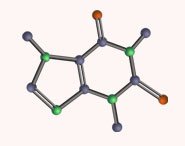


 علم الكيمياء
علم الكيمياء 
 الكيمياء التحليلية
الكيمياء التحليلية 
 الكيمياء الحياتية
الكيمياء الحياتية 
 الكيمياء العضوية
الكيمياء العضوية 
 الكيمياء الفيزيائية
الكيمياء الفيزيائية
 الكيمياء اللاعضوية
الكيمياء اللاعضوية 
 مواضيع اخرى في الكيمياء
مواضيع اخرى في الكيمياء
 الكيمياء الصناعية
الكيمياء الصناعية |
أقرأ أيضاً
التاريخ: 2023-07-30
التاريخ: 25-11-2019
التاريخ: 8-9-2020
التاريخ: 15-5-2017
|
When you look at a real NMR spectrum you will see that the scale does not appear to be in magnetic field units, nor in frequency, nor yet even energy, units, but in ‘parts per million’ (ppm). There is a very good reason for this. The exact frequency at which the nucleus reso nates depends on the external applied magnetic field. This means that if the sample is run on a machine with a different magnetic fi eld, it will resonate at a different frequency. It would make life very difficult if we couldn’t say exactly where our signal was, so we say how far it is from some reference sample, as a fraction of the operating frequency of the machine. We know that all protons resonate at approximately the same frequency in a given magnetic field and that the exact frequency depends on what sort of chemical environment it is in, which in turn depends on its electrons. This approximate frequency is the operating frequency of the machine and simply depends on the strength of the magnet—the stronger the magnet, the larger the operating frequency. The precise value of the operating frequency is simply the frequency at which a standard reference sample resonates. In everyday use, rather than actually referring to the strength of the magnet in tesla, chemists usually just refer to its operating frequency. A 9.4 T NMR machine is referred to as a 400 MHz spectrom eter since that is the frequency in this strength field at which the protons in the reference sample resonate; other nuclei, for example 13C, would resonate at a different frequency, but the strength is arbitrarily quoted in terms of the proton operating frequency.



|
|
|
|
تحذير من "عادة" خلال تنظيف اللسان.. خطيرة على القلب
|
|
|
|
|
|
|
دراسة علمية تحذر من علاقات حب "اصطناعية" ؟!
|
|
|
|
|
|
|
الأمين العام للعتبة العبّاسية المقدّسة يستقبل المشاركات في حفل التكليف الشرعي
|
|
|